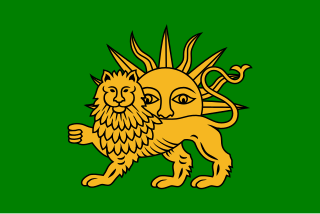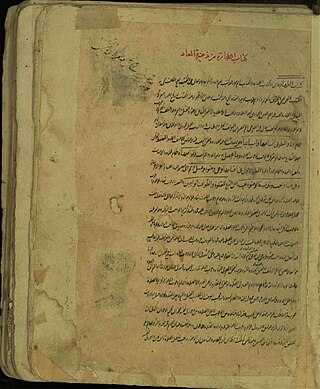Related Research Articles

The Safavid dynasty was one of Iran's most significant ruling dynasties reigning from 1501 to 1736. Their rule is often considered the beginning of modern Iranian history, as well as one of the gunpowder empires. The Safavid Shāh Ismā'īl I established the Twelver denomination of Shīʿa Islam as the official religion of the Persian Empire, marking one of the most important turning points in the history of Islam. The Safavid dynasty had its origin in the Safavid order of Sufism, which was established in the city of Ardabil in the Iranian Azerbaijan region. It was an Iranian dynasty of Kurdish origin, but during their rule they intermarried with Turkoman, Georgian, Circassian, and Pontic Greek dignitaries, nevertheless they were Turkic-speaking and Turkified. From their base in Ardabil, the Safavids established control over parts of Greater Iran and reasserted the Iranian identity of the region, thus becoming the first native dynasty since the Sasanian Empire to establish a national state officially known as Iran.

The Safavid order, also called the Safaviyya, was a tariqa founded by the Kurdish mystic Safi-ad-din Ardabili (1252–1334). It held a prominent place in the society and politics of northwestern Iran in the fourteenth and fifteenth centuries, but today it is best known for having given rise to the Safavid dynasty. While initially founded under the Shafi'i school of Sunni Islam, later adoptions of Shi'i concepts such as the notion of the Imamate by the children and grandchildren of Safi-ad-din Ardabili resulted in the order ultimately becoming associated with Twelverism.

Safi-ad-din Ardabili was a poet, mystic, teacher and Sufi master. He was the son-in-law and spiritual heir of the Sufi master Zahed Gilani, whose order—the Zahediyeh—he reformed and renamed the Safaviyya, which he led from 1301 to 1334.
Muhammad ibn Thalib ibn Abd Allah ibn Ni`mat Allah ibn Sadr ad-Din ibn Shaykh Baha' ad-Din ash-Shirazi was a 15th-century Persian physician from Shiraz, Iran.
Firuz-Shah Zarrin-Kolah was a Kurdish dignitary, and the seventh in the ancestral line of Shaykh Safi Ardabili, the eponym of the Safavid dynasty of Iran.
Qutb ad-Din Muhammad was the first Shah of Khwarezm from 1097 to 1127. He was the son of Anushtegin Gharchai.
The Safvat as-safa, also spelled Safvat al-safa or Safwat al-safa, is a hagiography of the Sufi shaykh Safi-ad-din Ardabili (1252–1334), founder of the Safaviya Sufi order.

Seyyed Nematollah Jazayeri was a prominent Shia scholar born in 1640 and died in 1700, in one of the islands around Basra. He was one of the grandchildren of Musa al-Kadhim. His paternal lineage is as follows: Seyyed Ne'mat Allah son of Seyyed Abd Allah son of Mohammad son of Hossein son of Ahmad son of Mahmoud son of Ghias Aldin son of Majd Aldin son of Noor Aldin son of Saad Allah son of Issa son of Musa son of Abdallah son of Musa al-Kadhim.
Sheikh Ahmad Zainuddin Makhdoom bin Sheikh Muhammad Al Gazzali, grandson of Sheikh Zainuddin Makhdoom I, was the writer, orator, historian, jurisprudent and spiritual leader and widely known as Zainuddin Makhdoom Second or Zaniudeen Makhdoom Al Sageer whose family originated from Yemen. He inherited the legacy of his grandfather and was installed as the Chief Qadi (judge) in the locality of Ponnani, Kerala, India, as well as appointed as the Chief Müderris in the historic Ponnani Dars at Ponnani Jum'ah Masjid, that built by Zainuddin Makhdoom I.
Musā ibn Khalil ibn Taghi ibn Jafar ibn Mohammad Ebrāhim Māzandarāni, Persian scribe and scholar of nineteenth century Persia. Musa was born into a family of good standing which originated in the northern Iranian region of Mazandaran.
Sirāj ud-DīnMuhammad ibn Muhammad ibn 'Abd ur-Rashīd Sajāwandī also known as Abū Tāhir Muhammad al-Sajāwandī al-Hanafī and the honorific Sirāj ud-Dīn was a 12th-century Hanafi scholar of Islamic inheritance jurisprudence, mathematics astrology and geography. He is primarily known for his work Kitāb al-Farāʼiḍ al-Sirājīyah, commonly known simply as "the Sirājīyah", which is a principal work on Hanafi inheritance law. The work was translated into English by Sir William Jones in 1792 for subsequent use in the courts of British India. He was the grand-nephew of qari Muhammad ibn Tayfour Sajawandi. He lies buried in the Ziārat-e Hazrat-o 'Āshiqān wa Ārifān in Sajawand.
Abū Badīl Ahmad ibn MuhammadSajāwandī was a 12th-century chronicler, commentator on the Quran, poet and orator. He was the son of the scholar Muhammad ibn Tayfour Sajawandi. He is mentioned in the Lubab ul-Albab of Aufi and the Chahar Maqalah of Nizami Aruzi as a great poet and orator at the court of Tughan-Shah Ibn Alp Arslan, under the name Malik al-Kalām Majd ad-Dīn Aḥmad Badi'hī Sajāwandī. However, as this event must have preceded Abu Badil's lifetime by close to a century, it is likely that these individuals have been confused from an early date, with Malik al-Kalām Aḥmad Badi'hī being known for his poetry, and Imâm-e KabīrAhmad ibn Muhammad Sajāwandī for his religious scholarship.
Mohammad ibn Masoud Ayyashi or Mohammad ibn Masoud Ayyashi Samarqandi, known as Ayyashi, was an eminent Shia Islam scholar. He had many works in the field of exegesis of the Quran, Islamic jurisprudence, Arabic literature and hadith. His exegesis of the Quran, known as Tafsir Ayyashi, is his most famous book.

The Isfahan Seminary is one of the oldest seminaries in Isfahan, Iran. Currently, more than 40 schools in Isfahan province are under the supervision of the Management Center of Isfahan Seminary and the leadership of the supreme authority of Grand Ayatollah Hossein Mazaheri.

Agha Hossein Khansari, full name Hossein ibn Jamal al-Din Mohammad Khansari, known as Mohaghegh Khansari and also known as "Master of all in all", who was nicknamed "the disciple of mankind" because of the many masters he acquired knowledge in their presence, was one of the great Iranian jurists of Isfahan jurisprudential school in the 11th century AH, who was also engaged in philosophy and wisdom. He was one of the high level scholars during the reign of Sultan Suleiman of the Safavid dynasty and after the death of Mir Seyyed Mohammad Masoom in 1683, he became the Shaykh al-Islām of Isfahan. His children are Jamaluddin Mohammad known as Agha Jamal Khansari and Raziauddin Mohammad known as Agha Razi Khansari.

Mohammad Bagher Sabzevari known as Mohaghegh Sabzevari was an Iranian Faqih and Shiite scholar from the 11th century AH, Shaykh al-Islām and the Imam of Friday Prayer of Isfahan.
Seyyed Qutb al-Din Mohammad Neyrizi was a prominent Iranian mystic of the Safavid period. He was 32nd Qutb of Zahabiya genealogy. All historians have written his name as Mohammad and his title as Qutb al-Din. In addition to his high position in the history of Shiite mysticism, he was one of the most important and influential political thinkers of the late Safavid period.

Zahabiya Sufism is a Shiite order. The history of dervishes from this order dates to the third century AH and Ma'ruf al-Karkhi. Some believe that the order originated during the ninth century AH in Iran; it first became popular in Khorasan and then in Shiraz during the early Safavid period.
References
- ↑ In the Silsilat-ol-nasab-i Safawiya (composed during the reign of Shah Suleiman)(1667–1694), written by Shah Hussab ibn Abdal Zahidi, the ancestry of the Safavid is traced back to the first Shi'i Imam as follows:
- Shaykh Safi al-din Abul Fatah Eshaq ibn (son of)
- Shaykh Amin al-Din Jabrail ibn
- Qutb al-din ibn
- Salih ibn
- Muhammad al-Hafez ibn
- Awad ibn
- Firuz Shah Zarin Kulah ibn
- Majd ibn
- Sharafshah ibn
- Muhammad ibn
- Hasan ibn
- Seyyed Muhammad ibn
- Ibrahim ibn
- Seyyed Ja'afar ibn
- Seyyed Muhammad ibn
- Seyyed Isma'il ibn
- Seyyed Muhammad ibn
- Seyyed Ahmad 'Arabi ibn
- Seyyed Qasim ibn
- Seyyed Abul Qasim Hamzah ibn
- Musa al-Kazim ibn
- Ja'far As-Sadiq ibn
- Muhammad al-Baqir ibn
- Imam Zayn ul-'Abedin ibn
- Hussein ibn
- Ali ibn
- Abi Taleb Alayha as-Salam.